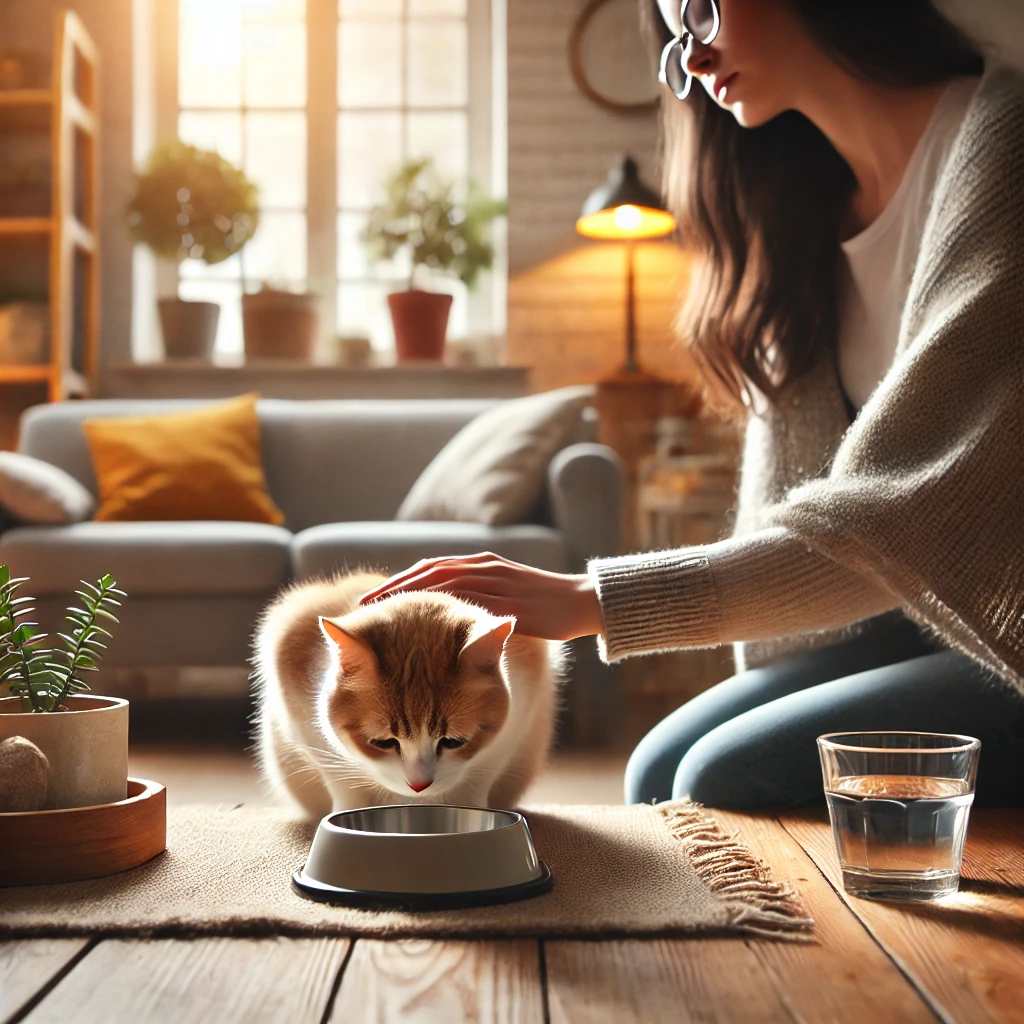
When your beloved feline companion refuses to eat, it can quickly become a source of anxiety and concern.
A lack of appetite, also known as anorexia in cats, can have serious health implications if left unaddressed.
But how long can cats go without food safely?
In this post, we’ll break down the reasons why cats may stop eating, how long they can survive without food, what you should do if it happens, and preventive steps to keep your cat healthy and happy.
Why Your Cat Might Not Be Eating
Common Causes of Loss of Appetite in Cats
- Illness or Medical Conditions
- Cats often refuse food when they are unwell. Dental disease, infections, gastrointestinal disorders, and kidney disease are some common culprits.
- Related Product Suggestion: Pet Thermometer for Cats and Dogs to help monitor your pet’s health.
- Stress or Anxiety
- Stressful changes in the home, new pets, or even rearranged furniture can impact a cat’s eating habits.
- Related Product Suggestion: Calming Diffuser Kit for Cats to reduce stress in the home.
- Diet Changes
- Switching to a new brand or flavor of food may cause your cat to refuse eating.
- Related Product Suggestion: Cat Food Sampler Pack for picky eaters.
When to Be Concerned
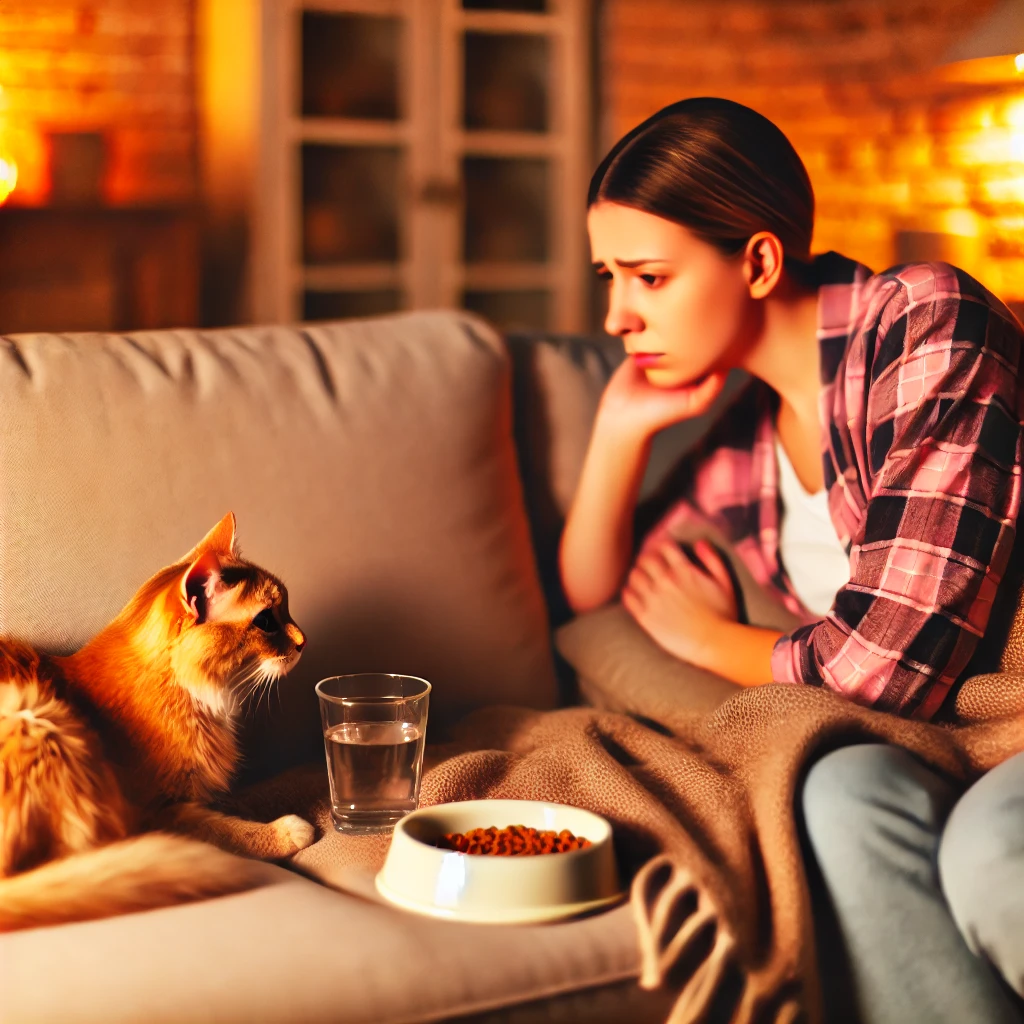
If your cat stops eating, it’s important to monitor their behavior closely.
While occasional missed meals might not be cause for immediate alarm, prolonged or complete refusal to eat can lead to serious health problems, and quick action is required.
Here’s what to look out for:
1. Duration Without Food
- 24-48 Hours: If your cat refuses food for more than a day or two, it’s a red flag. Cats have a unique metabolism, and going without food for more than 48 hours can lead to a potentially fatal condition known as hepatic lipidosis, or fatty liver disease, especially if they are overweight.
2. Weight Loss
- Rapid or noticeable weight loss is a sign of concern. Cats can lose muscle mass quickly when they’re not eating, and it can compromise their immune system.
3. Lethargy and Weakness
- If your cat becomes unusually lethargic, hides more often, or appears weak and disinterested in activities they usually enjoy, it may be a sign that their lack of appetite is due to an underlying illness.
4. Vomiting and Diarrhea
- Frequent vomiting or diarrhea, especially in combination with a refusal to eat, can quickly dehydrate your cat and lead to a dangerous situation. This often indicates gastrointestinal issues, infections, or other serious health problems.
5. Drooling or Pawing at the Mouth
- Cats experiencing dental pain, mouth ulcers, or other oral issues may refuse to eat and display symptoms such as drooling or pawing at their mouth.
6. Behavior Changes
- If your cat’s behavior changes drastically—becoming unusually aggressive, overly vocal, or suddenly reclusive—this can be a sign of distress, pain, or illness that is affecting their appetite.
7. Labored Breathing or Difficulty Swallowing
- Labored breathing, coughing, or difficulty swallowing are serious symptoms that may indicate a respiratory or throat issue, making it painful or challenging for your cat to eat.
8. Signs of Pain
- Cats may stop eating if they are in pain. Signs of pain in cats include limping, vocalizing when touched, excessive grooming of one area, or hiding away.
9. Excessive Drinking or No Water Intake
- If your cat is drinking much more water than usual or not drinking at all, it could point to kidney disease, diabetes, or other underlying problems.
10. Fever or Elevated Body Temperature
- A fever may cause a decrease in appetite. You can check for fever by gently feeling your cat’s ears and forehead (which may feel warm) or using a pet thermometer.
- Consider having a Pet Thermometer for Cats and Dogs on hand to monitor your cat’s temperature at home.
11. Refusal to Eat Both Wet and Dry Food
- If your cat refuses all types of food—wet, dry, and even their favorite treats—this could indicate a serious problem requiring immediate attention from a veterinarian.
When to Contact a Veterinarian
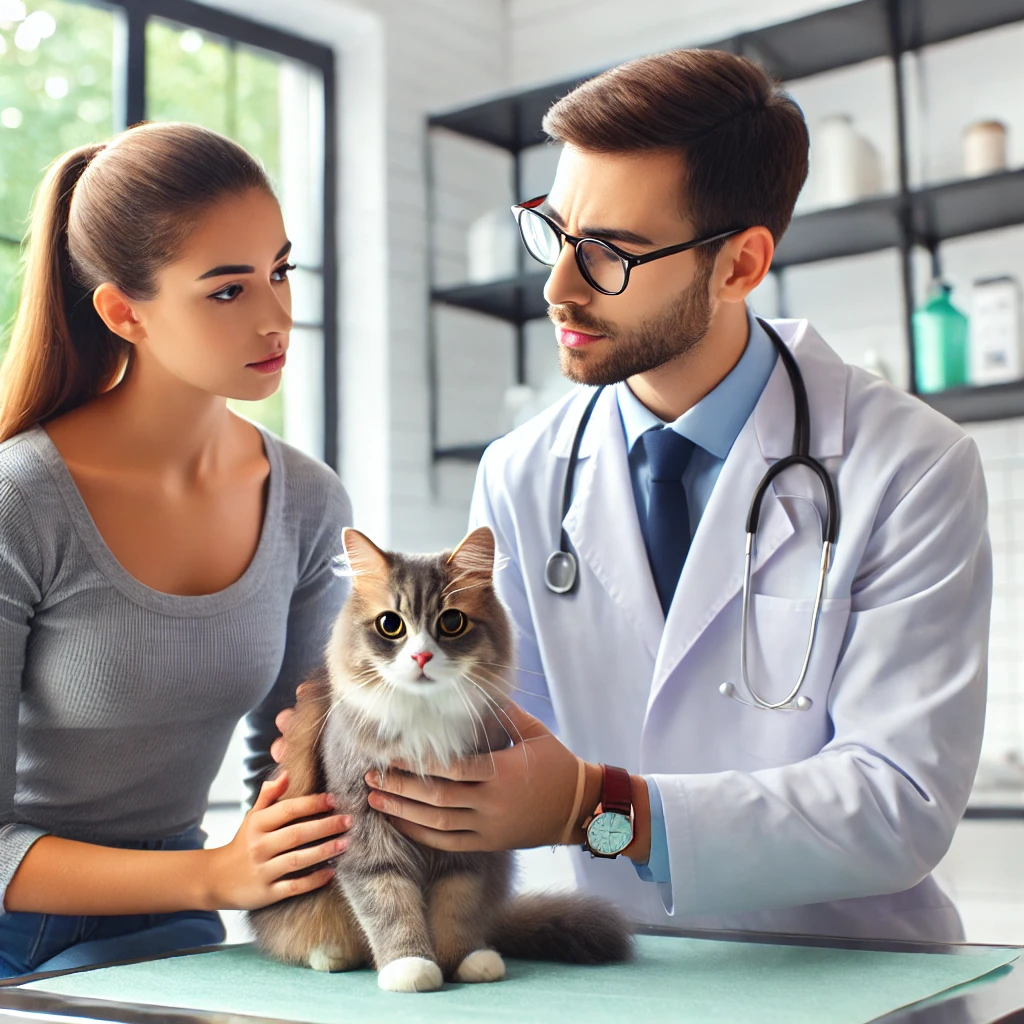
If your cat refuses food for more than 24-48 hours or exhibits any of the signs listed above, contact your veterinarian without delay.
Time is crucial when dealing with feline anorexia, as it can quickly spiral into more severe health complications.
A professional can help diagnose and treat the underlying cause of their refusal to eat, ensuring your cat returns to a healthy appetite.
How Long Cats Can Safely Go Without Food
When a cat stops eating, it’s essential to understand how long they can safely go without food before health complications arise. Unlike some other animals, cats have unique metabolic needs and require regular nutrition to stay healthy.
Prolonged fasting can quickly lead to severe health risks, such as hepatic lipidosis (fatty liver disease).
Below is a breakdown of how long different categories of cats can typically go without food, along with associated risks and considerations.
General Guidelines and Safety Timeframes
- Healthy Adult Cats: A healthy adult cat can generally go without food for up to a week but only if they continue drinking water. However, even a few days of not eating can have severe consequences for their liver and overall health.
- Kittens: Kittens have a much higher metabolism and smaller fat reserves. Going without food for more than 12-24 hours can be life-threatening.
- Senior Cats: Senior cats are more vulnerable to nutrient deficiencies and should not go without food for more than 24-48 hours.
- Sick or Underweight Cats: Cats with pre-existing health conditions or low body weight should not go without food for more than 24 hours.
Table: How Long Cats Can Safely Go Without Food
| Cat Category | Maximum Time Without Food | Considerations & Risks |
|---|---|---|
| Healthy Adult Cats | Up to 7 days (with water) | Prolonged fasting increases the risk of hepatic lipidosis. Even if they survive up to a week, the consequences may be severe, requiring immediate veterinary intervention. |
| Kittens | 12-24 hours | Kittens have high energy needs and low body reserves, making fasting extremely dangerous. Immediate intervention is necessary if they refuse to eat. |
| Senior Cats | 24-48 hours | Senior cats are more vulnerable to organ dysfunctions and nutritional imbalances. Prolonged fasting can lead to rapid health decline. |
| Sick or Underweight Cats | 24 hours | Cats with underlying conditions or low body mass are at high risk of complications like liver disease, dehydration, and rapid muscle loss. Seek medical attention urgently. |
| Pregnant/Nursing Cats | 12-24 hours | Pregnant or nursing cats need extra calories and nutrition. A lack of food can affect their health and the well-being of their kittens. |
| Cats Without Water | 3-4 days | Without water, cats are at high risk of dehydration, which can be fatal much faster than lack of food. They should have access to fresh water at all times. |
Risks of Prolonged Fasting in Cats
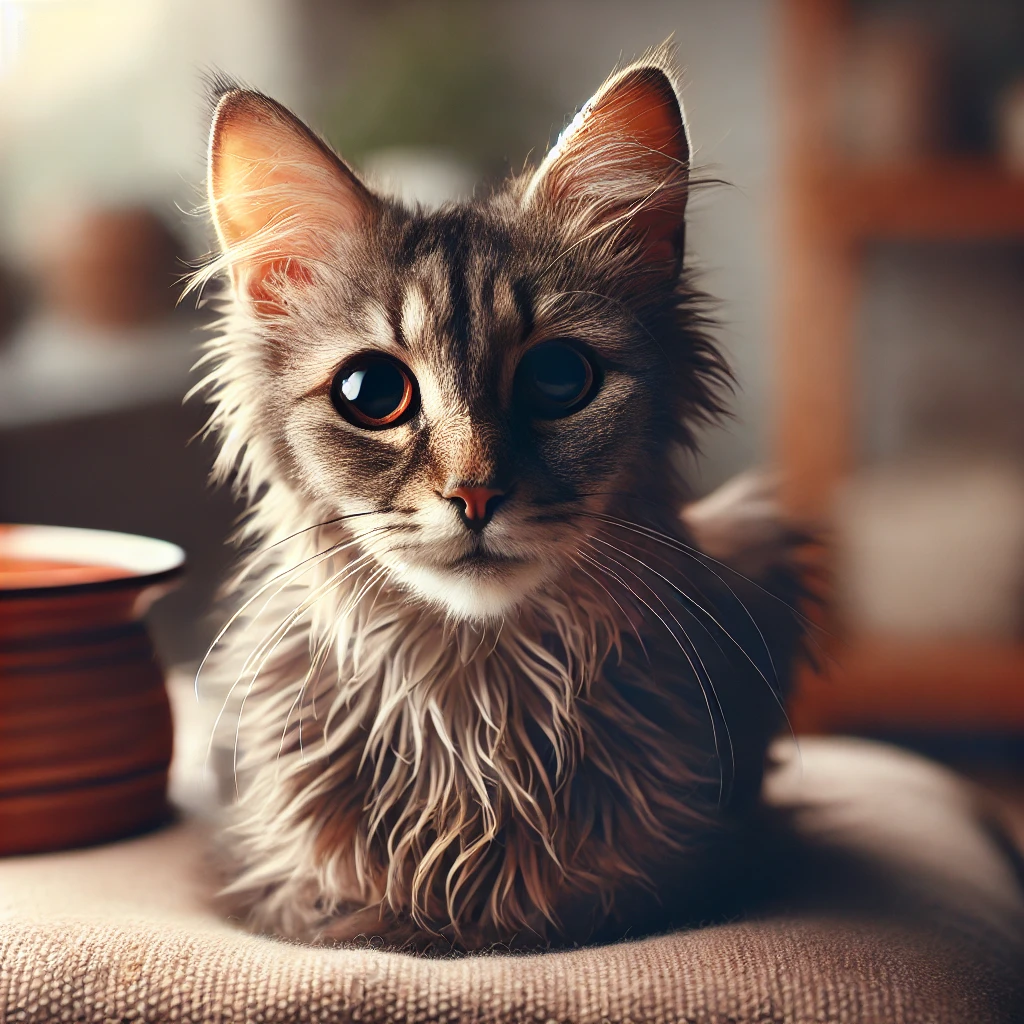
When a cat stops eating, even for a short period, it can have serious implications for their health and well-being.
Cats have a unique metabolism that requires regular intake of nutrients.
Unlike some animals that can go for extended periods without food, cats’ bodies are not designed for prolonged fasting.
Here’s a closer look at the most significant risks associated with prolonged fasting in cats:
1. Hepatic Lipidosis (Fatty Liver Disease)
One of the most critical risks of prolonged fasting in cats is hepatic lipidosis, commonly known as fatty liver disease.
This condition occurs when a cat’s body, in response to starvation, starts breaking down fat reserves for energy.
Since cats are not as efficient at processing large amounts of fat, the liver can become overwhelmed, leading to a dangerous buildup of fat cells that impairs liver function.
- Symptoms: Yellowing of the eyes (jaundice), vomiting, loss of appetite, weight loss, lethargy, and excessive drooling.
- Treatment: Hepatic lipidosis is potentially fatal and requires immediate veterinary intervention. Treatment often involves hospitalization, nutritional support through feeding tubes, and close monitoring.
2. Dehydration
While a cat may survive a bit longer without food, lack of water is a much more immediate concern.
Dehydration can occur rapidly and lead to severe complications, including organ failure.
- Signs of Dehydration: Sunken eyes, dry gums, lethargy, loss of skin elasticity, and decreased urination.
- Risks: Dehydration can exacerbate other health problems and lead to life-threatening conditions if not addressed quickly.
3. Nutritional Deficiencies
Cats require a balanced diet rich in essential nutrients, such as taurine, amino acids, and fatty acids.
Prolonged fasting leads to the depletion of these vital nutrients, causing a range of health issues.
- Taurine Deficiency: Cats cannot produce taurine on their own, making it a critical part of their diet. Deficiency can lead to vision loss, heart disease (dilated cardiomyopathy), and other systemic issues.
- Protein Deficiency: Without adequate protein intake, muscle mass is lost, and the immune system becomes compromised, making cats more susceptible to infections and disease.
4. Weakened Immune System
When a cat stops eating, its body is unable to produce enough energy to support immune function.
This leads to a weakened immune response, making it harder for the cat to fight off infections and illnesses.
- Risks: Increased susceptibility to bacterial, viral, and parasitic infections.
- Signs: Increased illness frequency, lethargy, and slow wound healing.
5. Muscle Wasting and Weight Loss
Prolonged fasting results in rapid loss of muscle mass and body weight as the body breaks down tissues to obtain essential nutrients.
- Effects: Loss of muscle tone, weakness, fatigue, and impaired physical function.
- Long-Term Impact: Severe weight loss and muscle wasting can lead to organ failure and death if not addressed promptly.
6. Organ Damage
When the body is deprived of adequate nutrition, vital organs such as the kidneys, heart, and liver can suffer damage.
- Kidney Damage: Chronic lack of nutrients can strain the kidneys, leading to dysfunction or kidney disease.
- Heart Damage: Lack of proper nutrition can lead to heart muscle weakening and conditions such as cardiomyopathy.
7. Behavioral Changes and Stress
Prolonged fasting can cause significant stress in cats, leading to changes in behavior.
- Signs: Increased aggression, hiding, vocalization, and withdrawal.
- Long-Term Impact: Stress and behavioral issues may persist even after the eating problem is resolved, affecting the cat’s overall quality of life.
8. Digestive Issues
When a cat hasn’t eaten for an extended period, the digestive system slows down.
Reintroducing food too quickly or improperly can lead to gastrointestinal upset.
- Risks: Vomiting, diarrhea, and lack of appetite when food is reintroduced.
- Advice: Consult a veterinarian to gradually reintroduce food and prevent further complications.
9. Electrolyte Imbalance
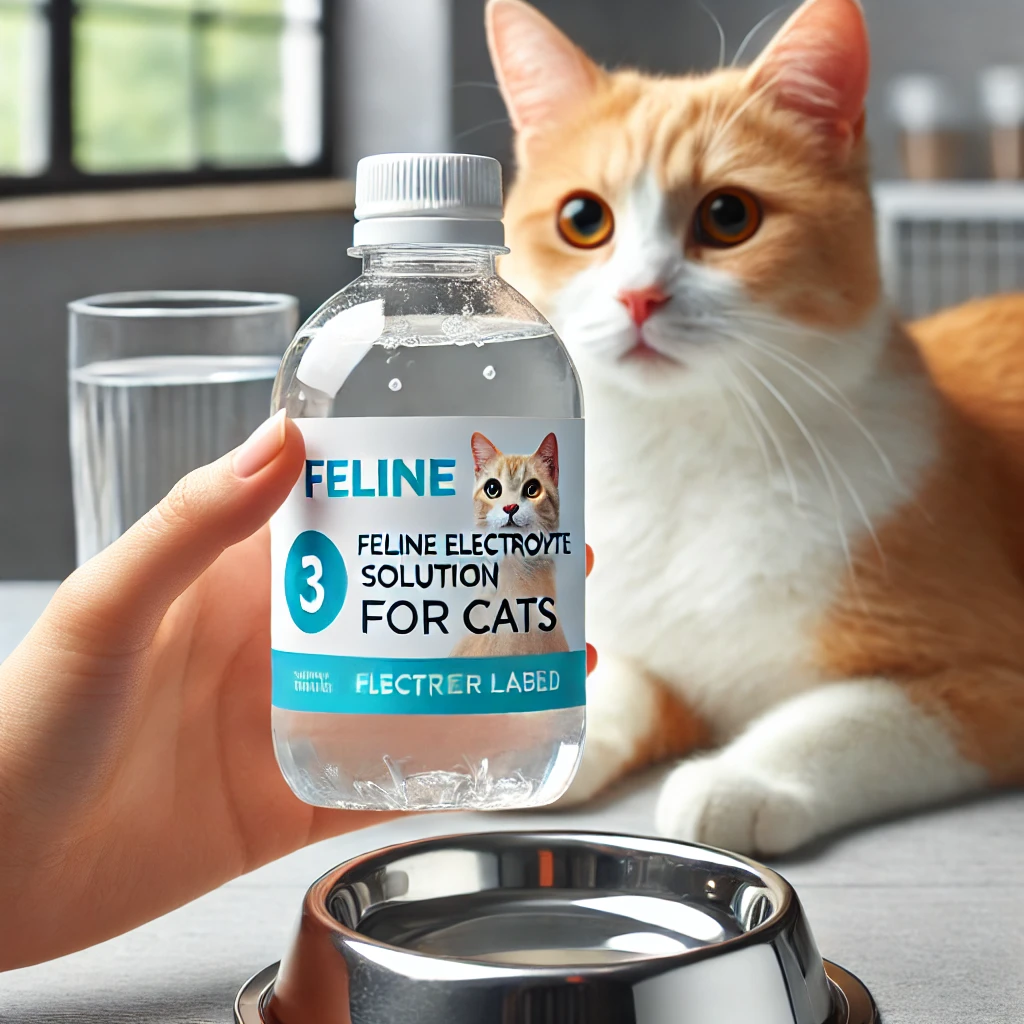
Lack of food intake can lead to an imbalance of electrolytes, which are crucial for normal cell function, muscle contraction, and nerve signaling.
- Symptoms: Muscle weakness, heart arrhythmias, seizures, and neurological issues.
- Treatment: Restoring balance often requires veterinary intervention, including IV fluids and electrolyte support.
Immediate Action is Crucial If your cat stops eating, even for just a day or two, it’s vital to monitor their behavior and seek veterinary care if needed.
Prolonged fasting is never “normal” for cats, and early intervention can prevent many of these severe complications, ensuring your feline friend returns to good health as quickly as possible.
When to Seek Immediate Veterinary Care
If your cat has stopped eating, it’s important to know when it’s time to seek immediate veterinary care.
While missing a meal here or there might not seem alarming, cats have unique dietary needs and even short-term fasting can quickly lead to serious health complications.
Here are specific signs and situations in which you should contact your veterinarian right away:
1. Refusal to Eat for More than 24-48 Hours
- Why it’s Critical: Cats are prone to developing hepatic lipidosis (fatty liver disease), which can occur if they go without food for even a couple of days. This condition can be life-threatening and requires immediate medical attention.
- Action to Take: Contact your veterinarian if your cat refuses all types of food, including treats, for more than a day or two.
2. Persistent Vomiting or Diarrhea
- Why it’s Critical: Frequent vomiting or diarrhea can lead to dehydration and electrolyte imbalances. When coupled with a lack of food intake, it poses a serious risk to your cat’s health.
- Action to Take: Seek veterinary care if your cat has multiple episodes of vomiting or diarrhea in a short period, especially if they are not eating.
3. Signs of Pain or Discomfort
- Common Indicators: Hissing or growling when touched, hiding, excessive grooming of one area, limping, or a hunched posture.
- Why it’s Critical: Pain often leads to a loss of appetite. The underlying cause could be dental disease, arthritis, internal injury, or another serious issue.
- Action to Take: Contact your vet immediately if you suspect your cat is in pain, as prompt treatment is needed.
4. Difficulty Swallowing or Breathing
- Common Indicators: Gagging, coughing, labored breathing, open-mouth breathing, or wheezing.
- Why it’s Critical: Difficulty swallowing or breathing may be caused by an obstruction, infection, or another life-threatening condition.
- Action to Take: This situation requires emergency veterinary care, as it can rapidly worsen.
5. Lethargy and Extreme Weakness
- Why it’s Critical: A sudden and drastic drop in energy levels or weakness can be a sign of severe illness, dehydration, or organ dysfunction.
- Action to Take: If your cat appears excessively tired, unwilling to move, or uninterested in their surroundings, contact your veterinarian as soon as possible.
6. Yellowing of the Skin, Gums, or Eyes (Jaundice)
- Why it’s Critical: Yellowing of the skin, gums, or eyes is a sign of liver dysfunction, commonly associated with hepatic lipidosis, a condition triggered by prolonged fasting.
- Action to Take: Seek immediate veterinary care to prevent further liver damage and complications.
7. Rapid Weight Loss
- Why it’s Critical: Cats can lose weight quickly when they stop eating, leading to muscle wasting and other systemic issues.
- Action to Take: Contact your veterinarian if you notice sudden or dramatic weight loss in your cat.
8. Behavioral Changes
- Common Indicators: Increased aggression, sudden fearfulness, hiding, excessive vocalization, or unusual quietness.
- Why it’s Critical: Behavioral changes can signal pain, stress, or an underlying medical condition.
- Action to Take: If your cat exhibits drastic changes in behavior alongside a loss of appetite, call your vet.
9. Dry Mouth, Sunken Eyes, or Other Signs of Dehydration
- Common Indicators: Dry or tacky gums, decreased skin elasticity (when you gently pinch the skin, it takes longer to return to its normal position), or sunken eyes.
- Why it’s Critical: Dehydration can be life-threatening and requires immediate medical intervention.
- Action to Take: If you suspect dehydration, your vet may need to administer fluids and address the underlying cause.
10. Dental Issues
- Common Indicators: Drooling, pawing at the mouth, bad breath, visible swelling, or difficulty chewing.
- Why it’s Critical: Dental disease can cause severe pain and lead to a refusal to eat.
- Action to Take: Your veterinarian can examine your cat’s mouth, provide pain relief, and treat any dental problems.
11. Excessive Thirst or No Interest in Water
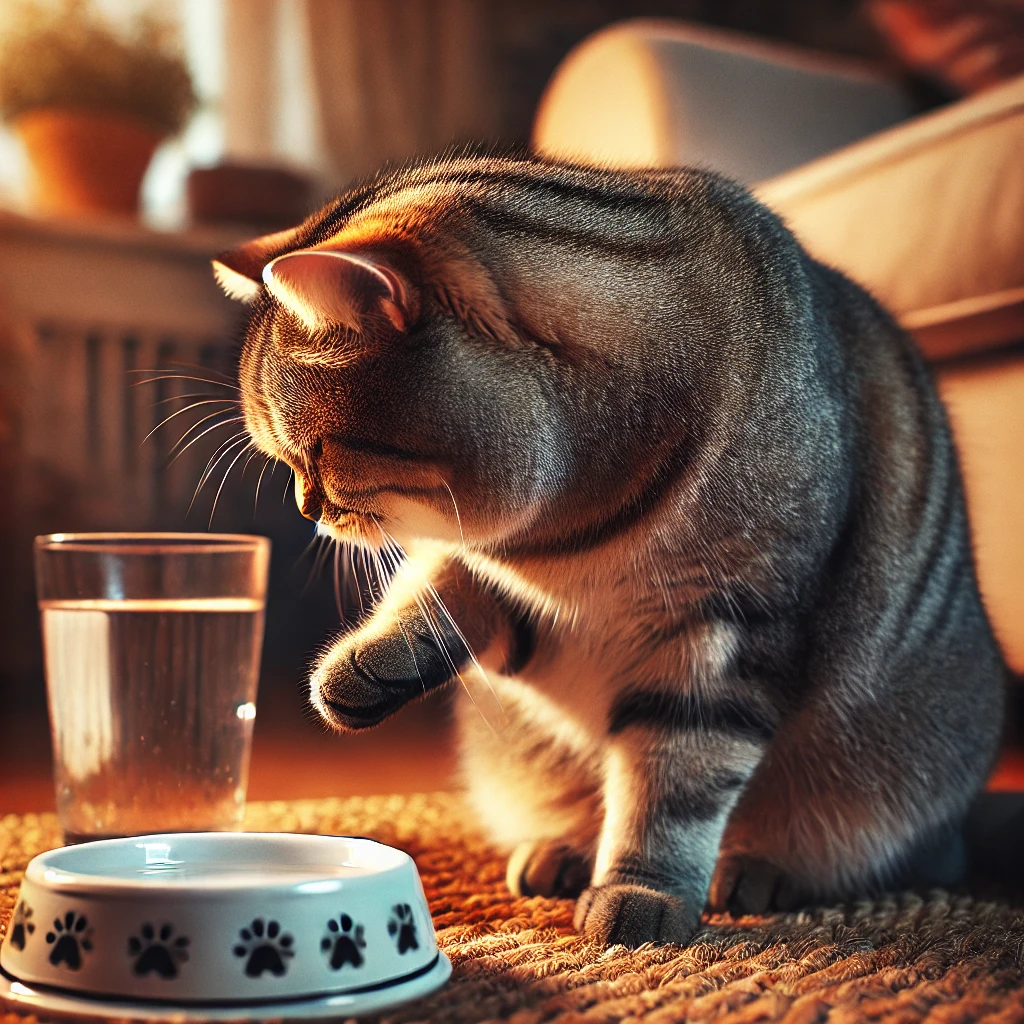
- Why it’s Critical: A sudden increase in water intake could indicate diabetes, kidney disease, or hyperthyroidism. On the other hand, refusal to drink can quickly lead to dehydration.
- Action to Take: Both conditions require prompt veterinary attention.
12. Blood in Stool or Vomit
- Why it’s Critical: Blood in the stool or vomit may indicate internal bleeding, infection, or trauma.
- Action to Take: This is a medical emergency and should not be ignored.
13. Unexplained Limping or Physical Trauma
- Why it’s Critical: Limping or signs of trauma, such as swelling or cuts, can lead to pain and loss of appetite.
- Action to Take: Veterinary care is necessary to diagnose and treat injuries or underlying conditions causing the limping.
14. Fever or Elevated Body Temperature
- Common Indicators: Warm ears, warm body, lethargy, shivering.
- Why it’s Critical: Fever is often a sign of infection or inflammation and can lead to a decrease in appetite.
- Action to Take: Use a pet thermometer to check for fever, but consult your veterinarian immediately for diagnosis and treatment.
Immediate Action Tips

- Call the Vet: If you notice any of these symptoms, call your veterinarian and explain the situation.
- Monitor Symptoms: Keep track of how long your cat has refused food, other symptoms, and any changes in behavior.
- Prepare for a Vet Visit: Bring a list of observed symptoms, changes in behavior, and any recent changes to your cat’s diet or environment.
Early intervention is crucial for preventing serious health issues, ensuring a quicker recovery, and keeping your feline friend safe and healthy.
If in doubt, always err on the side of caution and consult a professional.
Steps to Take If Your Cat Isn’t Eating
Immediate Actions
- Try a Different Food: Offer a different type of food (wet, dry, or a different flavor).
- Related Product Suggestion: High-Protein Wet Cat Food.
- Warm Up the Food: Heating food can make it more appealing due to the aroma.
- Hand Feeding: Sometimes, offering food by hand encourages eating.
- Change the Environment: Ensure a quiet, stress-free area for meals.
Temporary Feeding Solutions
- Related Product Suggestion: Cat Appetite Stimulant Drops.
Prevention Tips to Keep Your Cat Eating Well
- Maintain a Consistent Routine
- Cats thrive on routine, so keep feeding times and environments consistent.
- Balanced Nutrition
- Ensure you are feeding high-quality, nutritionally complete cat food.
- Related Product Suggestion: Balanced Cat Food Formula.
- Reducing Stress
- Create a stable environment with plenty of hiding spots and activities.
- Related Product Suggestion: Interactive Cat Toy to keep your cat stimulated.
Real-Life Stories or Testimonials (Optional)
Example: “When our cat stopped eating after a move, we tried offering warmed-up wet food, providing calming diffusers, and creating a safe space.
These steps worked wonders! Learn more about what helped here.”
FAQs
- How long can cats go without food and water?
- A cat can go a few days without food but typically shouldn’t go more than 24-48 hours without water.
- Can I use human appetite stimulants for my cat?
- No, only use products recommended by your vet.
Conclusion
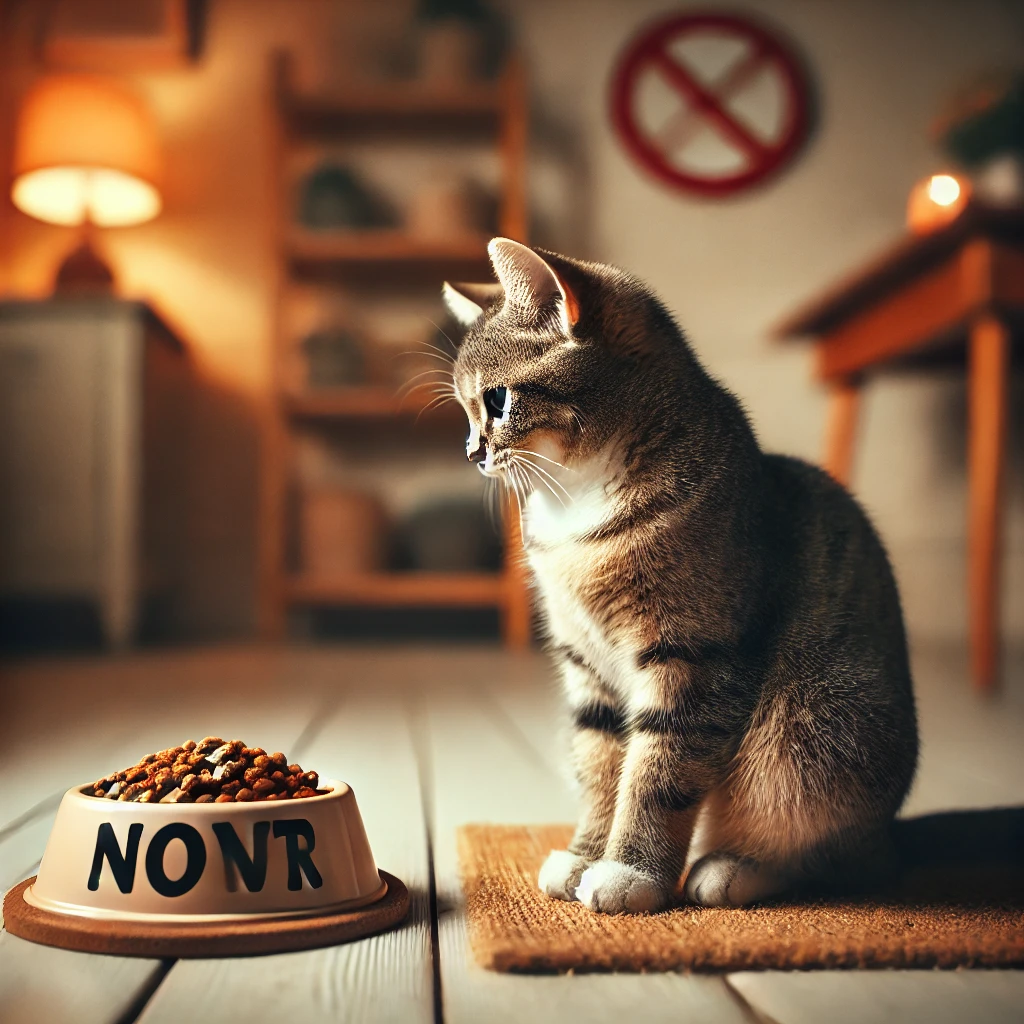
Seeing your cat refuse to eat can be concerning, but with prompt action and appropriate care, you can address this issue and help your feline friend regain their appetite.
If you’re ever unsure, don’t hesitate to consult a veterinarian for professional advice.
Top 10 Best Cat Toys to Keep Your Feline Friend Entertained for Hours
Can Dogs Eat Cat Food? Here’s What the Experts Say
Affiliate Disclosure: This post may contain affiliate links. If you click and make a purchase, we may receive a small commission at no additional cost to you.
As an Amazon Associate, we earn from qualifying purchases.



